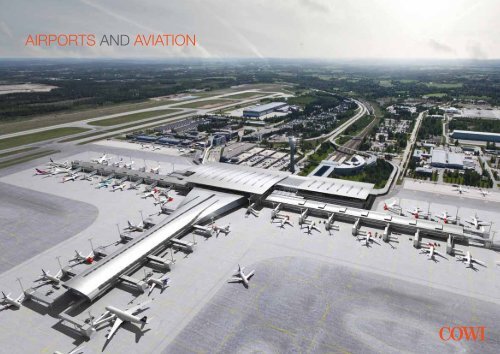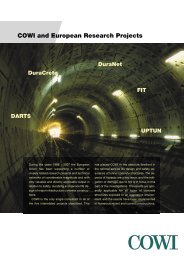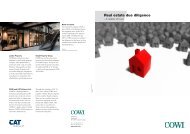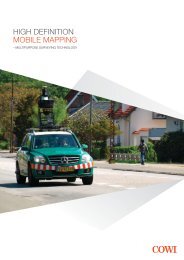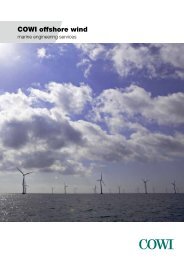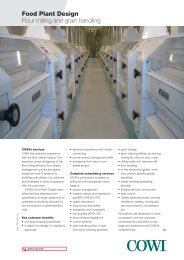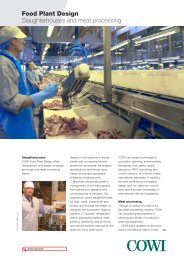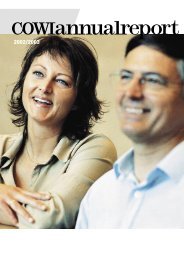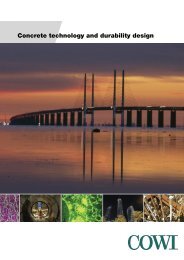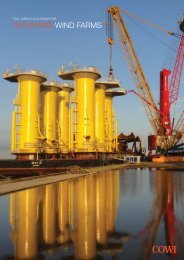Airports and aviation (pdf) - Cowi
Airports and aviation (pdf) - Cowi
Airports and aviation (pdf) - Cowi
You also want an ePaper? Increase the reach of your titles
YUMPU automatically turns print PDFs into web optimized ePapers that Google loves.
<strong>Airports</strong> <strong>and</strong> <strong>aviation</strong>
COWI Group<br />
COWI is a leading international consultancy company<br />
founded in 1930 in Denmark. COWI is privately owned<br />
<strong>and</strong> entirely independent of any manufacturer, supplier<br />
or contractor.<br />
The COWI Foundation is the majority shareholder. The<br />
Foundation supports research <strong>and</strong> development in various<br />
fields of consultancy activities.<br />
The corporate head office of COWI Group is located in<br />
Kongens Lyngby 12 km north of Copenhagen, the capital<br />
of Denmark.<br />
COWI’s formula for success is simple yet effective. We<br />
create value for our customers by thinking 360° around<br />
the challenges we meet. The 360° approach leads to<br />
more coherent solutions for our customers – <strong>and</strong> ultimately<br />
in the society at large.<br />
ECONOMICS, MANAGEMENT AND PLANNING<br />
Economic analyses <strong>and</strong> tools<br />
Financial analyses <strong>and</strong> law<br />
Evaluation <strong>and</strong> impact assessment<br />
Organisational development <strong>and</strong> social studies<br />
Communication <strong>and</strong> policy advice<br />
Transport planning <strong>and</strong> modelling<br />
Public transport <strong>and</strong> ITS<br />
Spatial planning <strong>and</strong> urban development<br />
WATER AND ENVIRONMENT<br />
Health, safety <strong>and</strong> environment<br />
Water supply <strong>and</strong> waste water<br />
Water <strong>and</strong> natural resources management<br />
Environmental impact assessment <strong>and</strong> monitoring<br />
Solid waste management<br />
Contaminated sites<br />
Strategic environmental consultancy<br />
COWI employs in the order of 6,100 staff, of which more than 50% are based<br />
outside Denmark in subsidiaries, branch offices or projects offices. Most of the<br />
employees are professionals with Ph.D., M.Sc. or B.Sc. degrees in civil, structural,<br />
geotechnical, mechanical or electrical engineering <strong>and</strong> other academic areas<br />
such as environmental science, geology, hydrology, chemistry, biology, agronomy,<br />
sociology, economics <strong>and</strong> planning.<br />
In 2011 the annual turnover was 631 million EUR (821 million USD). The majority<br />
of the turnover of the company is generated outside Denmark in more than 100<br />
countries around the world.<br />
FULL CIRCLE SOLUTIONS<br />
Our 360° approach takes lots of<br />
expertise. Fortunately, we have<br />
the people to back it up.<br />
With a full set of world-class<br />
competences within engineering,<br />
economics <strong>and</strong> environmental<br />
management COWI is able to<br />
create coherence in the largest<br />
<strong>and</strong> most complex projects in the<br />
world.<br />
GEOGRAPHICAL INFORMATION AND IT<br />
GIS <strong>and</strong> IT<br />
3D visualisation <strong>and</strong> modelling<br />
Maps <strong>and</strong> geodata products<br />
Mapping <strong>and</strong> data capture<br />
Surveying<br />
Property rights <strong>and</strong> l<strong>and</strong> administration<br />
INDUSTRY AND ENERGY<br />
Industry<br />
Energy<br />
Oil <strong>and</strong> gas<br />
BRIDGE, TUNNEL AND MARINE STRUCTURES<br />
Bridges<br />
Tunnels<br />
Structures for infrastructure<br />
Offshore wind farms<br />
Marine, coastal <strong>and</strong> geotechnical engineering<br />
Operation <strong>and</strong> maintenance<br />
Risk management <strong>and</strong> analysis<br />
Service life design<br />
BUILDINGS<br />
Building design<br />
Project management consultancy<br />
Master planning <strong>and</strong> urban development<br />
Refurbishment <strong>and</strong> retrofit<br />
Sustainable <strong>and</strong> green buildings<br />
Fire engineering<br />
RAILWAYS, ROADS AND AIRPORTS<br />
Roads <strong>and</strong> highways<br />
Railways<br />
Light rails<br />
Metros<br />
<strong>Airports</strong>
<strong>Airports</strong> <strong>and</strong> <strong>aviation</strong> 3<br />
Photo: Arne V. Petersen,<br />
Københavns Lufthavne A/S
Aviation sector<br />
Aviation services<br />
››<br />
Business planning<br />
››<br />
Market studies<br />
››<br />
Data mining <strong>and</strong> route analysis<br />
››<br />
Traffic forecasting<br />
››<br />
Catchment area analysis<br />
››<br />
Sustainable transport<br />
››<br />
CO 2<br />
quotas management <strong>and</strong><br />
impact assessment<br />
››<br />
Emission tax consultancy<br />
››<br />
L<strong>and</strong>side access infrastructure<br />
planning<br />
››<br />
L<strong>and</strong>side access infrastructure<br />
design<br />
››<br />
Airside planning/infrastructure<br />
››<br />
Airport City planning<br />
››<br />
Unmanned Aircraft Systems<br />
(UAS) consultancy<br />
Even the most effective <strong>and</strong> well functioning airports are<br />
highly dependant on the adjacent infrastructure in the air<br />
<strong>and</strong> on the ground. COWI has more than 75 years experience<br />
in transportation consultancy <strong>and</strong> management covering<br />
a wide range of projects in the fields of air <strong>and</strong> ground<br />
transport.<br />
Our comprehensive spectrum of transportation services<br />
ranges from transport system planning <strong>and</strong> management<br />
to planning <strong>and</strong> design of roads, tunnels, bridges, ports,<br />
marine structures <strong>and</strong> intermodal facilities.<br />
Within the <strong>aviation</strong> <strong>and</strong> ground transportation sectors<br />
COWI delivers services to clients in both the public <strong>and</strong><br />
private sector including authorities, airlines, airport operators<br />
<strong>and</strong> investors.<br />
The services for infrastructure projects include all phases<br />
from initial planning <strong>and</strong> feasibility studies through to design,<br />
construction <strong>and</strong> commissioning as well as maintenance<br />
management <strong>and</strong> rehabilitation.<br />
Projects in the transport sector are often characterized by a close interrelation<br />
between the physical infrastructure, the economics <strong>and</strong> the environmental impact.<br />
The COWI concept where economics, engineering <strong>and</strong> environmental science is<br />
combined within one organization offers unique added value for the client<br />
through cross disciplinary management <strong>and</strong> optimization.<br />
Major airport projects also involve a broad range of other disciplines including<br />
transport planning, environmental management, strategic economic optimization,<br />
cost benefit analysis, building, road, railway design <strong>and</strong> IT & telecommunication<br />
design.<br />
“The core business of COWI<br />
lies within the spheres of our<br />
three service lines ranging<br />
from classical engineering<br />
through environmental science<br />
to modern economic<br />
analyses <strong>and</strong> cross disciplinary<br />
management”
<strong>Airports</strong> <strong>and</strong> <strong>aviation</strong> 5<br />
<strong>Airports</strong><br />
COWI has carried out more than 600 airport projects worldwide <strong>and</strong> employs a<br />
large number of specialists in a variety of disciplines within the fields of airport planning,<br />
design, operation <strong>and</strong> transaction advisory services.<br />
Transaction advisory services<br />
The combination of technical specialists <strong>and</strong> project managers experienced in<br />
airport transactions creates a unique platform for providing coherent services to<br />
both the <strong>and</strong> the buying side of an airport transaction.<br />
Airport planning<br />
COWI’s vast experience in airport planning is gained from projects spanning from<br />
small domestic airports to major international airports with the largest aircraft<br />
types.<br />
Programme management<br />
COWI takes pride in managing time, cost <strong>and</strong> quality in major development programmes;<br />
utilising cross disciplinary optimisation within a dynamic environment<br />
to ensure successfull project outcomes.<br />
Buildings<br />
COWI uses state-of-the-art engineering to design passenger<br />
terminal buildings, air traffic control towers <strong>and</strong><br />
other airport buildings. Close collaboration with the architect<br />
ensures designs with a high degree of functionality,<br />
flexibility for future needs <strong>and</strong> which are cost-efficient <strong>and</strong><br />
architectural l<strong>and</strong>marks.<br />
Operation <strong>and</strong> maintenance<br />
During the process of preparing manuals for operation<br />
<strong>and</strong> maintenance we have often identified potentials for<br />
considerable savings in the organisational set-up, in the<br />
use of equipment or in operational <strong>and</strong> maintenance procedures.<br />
“COWI is in the top 5 as international<br />
airport designers,<br />
measured on turnover outside<br />
own home market”<br />
Source: Engineering News Record<br />
february 2012.<br />
Civil engineering<br />
Civil engineering is one of the key elements of our involvement in airport projects.<br />
Our pavement engineers have developed unique recycling concepts for both<br />
concrete <strong>and</strong> asphalt.<br />
Technical installations<br />
The engineering design of electrical airport installations<br />
that meet the dem<strong>and</strong> of a modern airport is a discipline,<br />
where we have extensive experience. Other disciplines<br />
are fuel supply systems <strong>and</strong> leak detection.<br />
Model photo: Team_T AS
Services<br />
General:<br />
››<br />
Analyse the market <strong>and</strong><br />
competition<br />
››<br />
Conduct technical due<br />
diligence<br />
››<br />
Analyze revenue / commercialization<br />
options.<br />
For the selling side:<br />
››<br />
Development of minimum technical<br />
requirements<br />
››<br />
Assist in implementation of<br />
transaction, e.g. short listing of<br />
bidders, defining evaluation<br />
criteria, evaluation of technical<br />
bids.<br />
For the investor side:<br />
››<br />
Development of dem<strong>and</strong> driven<br />
CAPEX<br />
››<br />
Development of OPEX linked to<br />
the traffic projections<br />
››<br />
Detect environmental issues<br />
with constrants <strong>and</strong>/or cost<br />
implications.<br />
Develop the above services with<br />
small broad teams providing<br />
flexibility to cater for late changes<br />
in the process of financial<br />
modeling.<br />
Technical transaction advisory<br />
services<br />
Our services related to airport privatisation <strong>and</strong> tendering include cross functional optimisation<br />
of master plans, CAPEX plans, OPEX, commercial plans <strong>and</strong> terminal design in<br />
close collaboration with disciplines as route development, business planning <strong>and</strong> financial<br />
valuation.<br />
PPP <strong>and</strong> BTO projects<br />
COWI staff has a broad experience from airport privatization<br />
projects. COWI can offer key staff with many years<br />
experience from investor side participation in airport privatisations<br />
<strong>and</strong> tendering in Europe, Middle East, Asia<br />
North- <strong>and</strong> South America.<br />
COWI has experience as technical consultants working<br />
for the selling as well as the investor side in airport transactions.<br />
Technical services<br />
COWI’s in house specialists are in addition to the cross functional optimisation<br />
able to deliver detailed support in areas as; airport planning, capacity/dem<strong>and</strong><br />
analysis (airfield, terminals, access systems), design of runway, taxiways <strong>and</strong><br />
apron, airfield ground lighting (AGL), Navaids, fuelling systems, design of access<br />
roads, Curb <strong>and</strong> parking areas, design of passenger terminals <strong>and</strong> other buildings<br />
(cargo facilities, ATC towers, fire stations, hangars, multi storey car park<br />
etc.).
<strong>Airports</strong> <strong>and</strong> <strong>aviation</strong> 7<br />
Airport planning<br />
The basis for COWI’s airport planning services is our thorough knowledge<br />
of the details <strong>and</strong> functions of the physical facilities of the airside <strong>and</strong> l<strong>and</strong>side<br />
of an airport.<br />
The development of an airport master plan is a complex task. The objective is to<br />
ensure that the immediate development is harmonised with the long-term development<br />
strategies <strong>and</strong> that the capacity is, at all times, sufficient but not excessive.<br />
This goes for new airports as well as for the extension of existing airports.<br />
Business plans, traffic forecasts <strong>and</strong> feasibility studies<br />
COWI analyses the development of airports in terms of passenger <strong>and</strong> cargo<br />
volumes. Combined with the commercial aspects, the results are used in feasibility<br />
calculations allowing the airport management to determine their final development<br />
strategy.<br />
Physical planning<br />
The master planning covers all elements of an airport,<br />
such as the runway/taxiway system including airfield<br />
lighting <strong>and</strong> navigational aids; passenger terminal buildings<br />
including apron <strong>and</strong> l<strong>and</strong>side access facilities, control<br />
tower, freight terminal, maintenance <strong>and</strong> administration<br />
buildings, fire rescue facilities <strong>and</strong> all information <strong>and</strong><br />
security systems <strong>and</strong> utilities.<br />
Costing<br />
The master plan work will be concluded with cost estimates<br />
of the various alternatives based on COWI’s comprehensive<br />
cost databases.<br />
Services<br />
››<br />
Site selection studies<br />
››<br />
Feasibility studies<br />
››<br />
Traffic forecasts<br />
››<br />
Capacity / dem<strong>and</strong> analyses<br />
››<br />
CAPEX <strong>and</strong> OPEX estimates<br />
››<br />
Aircraft movement analyses<br />
››<br />
Runways, taxiways <strong>and</strong><br />
aprons<br />
››<br />
Terminals<br />
››<br />
L<strong>and</strong>side access systems<br />
››<br />
Cargo<br />
››<br />
IT systems<br />
››<br />
Environmental assessments
Programme management<br />
Services<br />
››<br />
Procurement strategies<br />
››<br />
Management consultancy<br />
››<br />
Interface management<br />
››<br />
Design management<br />
››<br />
Construction management<br />
››<br />
Change management<br />
››<br />
Quality assurance<br />
››<br />
Value management<br />
››<br />
Risk management<br />
››<br />
Sustainability assessments<br />
››<br />
Claims <strong>and</strong> dispute<br />
management<br />
COWI’s ability to tailor programme management to a specific programme is<br />
based on our experience in working with public <strong>and</strong> private clients; in depth<br />
knowledge of the consultancy <strong>and</strong> construction sector in the respective regions<br />
combined with experience from a large number of projects in the air transport<br />
sector.<br />
Procurement strategies<br />
Procurement strategy is a vital element in successful<br />
programme management.<br />
Though a procurement strategy finds its basis in the nature<br />
of the project, the national legislation <strong>and</strong> regional<br />
market must be taken into consideration at an early<br />
stage.<br />
Design management<br />
Larger modern airports are growing into multimodal airport cities <strong>and</strong> commercial<br />
revenues are getting more <strong>and</strong> more important for the ability of the airport to<br />
deliver a quality product to passengers <strong>and</strong> business partners.<br />
In this context complexity is constantly growing <strong>and</strong> visionary design management<br />
is becoming increasingly important in order to be able to follow the dynamic<br />
changes in a volatile <strong>aviation</strong> sector.<br />
Photo: Espen Granli<br />
The combination of a strong centralised knowledge base<br />
<strong>and</strong> regional presence gives COWI the ability to design<br />
the optimum procurement strategy for the client leading<br />
to the right balance between quality, time <strong>and</strong> cost.<br />
Design of larger airport projects includes balancing the dem<strong>and</strong>s of a variety of<br />
stakeholders. COWI is expert in managing stakeholder requirements through<br />
open communication <strong>and</strong> facilitation.<br />
Transforming the design input into world class, efficient <strong>and</strong> flexible infrastructure<br />
is obtained by utilising the combined competences of the three COWI<br />
spheres - engineering, economics <strong>and</strong> environmental science.
<strong>Airports</strong> <strong>and</strong> <strong>aviation</strong> 9
Civil engineering<br />
Airport civil engineering comprises design, tendering, contracting <strong>and</strong> supervision<br />
services in connection with runways, taxiways, aprons <strong>and</strong> l<strong>and</strong>side<br />
access facilities.<br />
Services<br />
››<br />
Geotechnics<br />
››<br />
Drainage<br />
››<br />
Pavements/recycling<br />
››<br />
Geometrical layout<br />
››<br />
Runways <strong>and</strong> taxiways<br />
››<br />
Aprons<br />
››<br />
De-icing st<strong>and</strong>s<br />
››<br />
Airside/l<strong>and</strong>side roads <strong>and</strong><br />
parking<br />
››<br />
Project <strong>and</strong> construction<br />
management<br />
Geometrical design<br />
COWI employs software showing the path of different<br />
types of aircraft enabling us to secure that all requirements<br />
of ICAO will be met when designing runways, taxiways<br />
<strong>and</strong> aprons. In order to accommodate different aircraft<br />
mixes, flexible aircraft st<strong>and</strong>s may be introduced to<br />
minimise the length of building facades <strong>and</strong> thereby reduce<br />
initial <strong>and</strong> future cost.<br />
Pavement design<br />
COWI employs modern pavement designs using both<br />
external <strong>and</strong> in-house developed software in order to<br />
cater for different climatic <strong>and</strong> loading conditions. We employ new technologies<br />
such as the recycling of asphalt <strong>and</strong> concrete pavements when existing airfield<br />
pavements are rehabilitated. These technologies result in savings of 20-40<br />
percent compared to traditional rehabilitation methods.<br />
››<br />
Performance-driven specifications, e.g. superpave<br />
››<br />
Pavement analysis <strong>and</strong> modelling<br />
››<br />
Utilisation of waste <strong>and</strong> marginal materials<br />
››<br />
Specialised binders
<strong>Airports</strong> <strong>and</strong> <strong>aviation</strong> 11
Buildings<br />
COWI’s services related to the design <strong>and</strong> construction of airport buildings include<br />
planning, programming, design, tendering <strong>and</strong> construction supervision of the facilities.<br />
We also have extensive experience in project management, both in the design<br />
phase <strong>and</strong> construction phase. Our experience is founded on many years of involvement<br />
in airport projects.<br />
Services<br />
››<br />
Passenger terminals<br />
››<br />
Control towers<br />
››<br />
Cargo terminals<br />
››<br />
Hangars<br />
››<br />
Administration buildings<br />
››<br />
Maintenance buildings<br />
››<br />
Catering buildings<br />
››<br />
Hotels<br />
Specialist areas<br />
››<br />
Structural engineering<br />
››<br />
Value engineering<br />
››<br />
Fire protection<br />
››<br />
Acoustics<br />
››<br />
Indoor climate<br />
- sustainable solutions<br />
››<br />
IT installations<br />
Airport buildings<br />
Airport buildings encompass many specialised buildings<br />
such as passenger terminal buildings, control towers,<br />
cargo buildings, hangars, airport maintenance buildings<br />
<strong>and</strong> fire <strong>and</strong> rescue stations.<br />
A number of other buildings also play an important part<br />
in many airports. We have design experience with most<br />
types of airport buildings <strong>and</strong> their interfaces with the civil<br />
works including car parks, catering <strong>and</strong> hotels. On all of<br />
our projects we create synergies between technology<br />
<strong>and</strong> architecture, <strong>and</strong> focus on functionality, buildability,<br />
construction technology, energy savings <strong>and</strong> sustainable<br />
developments.<br />
COWI has a number of LEED (Leadership in Energy <strong>and</strong> Environmental Design)<br />
certified engineers. LEED is normally used for certifying single buildings, but<br />
COWI has developed a method where LEED can also be used to screen sustainability<br />
in an entire property portfolio. LEED allows you to asses the sustainability<br />
of a property in six categories; the site <strong>and</strong> its location, water consumption,<br />
energy consumption, materials <strong>and</strong> resources, indoor climate <strong>and</strong> innovation.<br />
Design objectives<br />
Our aim is to ensure that the client’s objectives are always exceeded were possible.<br />
Therefore, COWI’s first planning step is to define these objectives in cooperation<br />
with the client. Issues for considerations are typically functionality, flexibility,<br />
architectural aesthetic <strong>and</strong> cost.<br />
Photo: Trond Isaksen /<br />
Oslo Lufthavn AS
<strong>Airports</strong> <strong>and</strong> <strong>aviation</strong> 13<br />
Photo: Tao Lytzen
Operation <strong>and</strong> maintenance<br />
The basis of airport operation <strong>and</strong> maintenance services is a detailed underst<strong>and</strong>ing<br />
og the function of physical facilities <strong>and</strong> systems, aligned with the<br />
appropriate people <strong>and</strong> processes to create a smooth operation.<br />
COWI has gained intimate knowledge of airport operations<br />
<strong>and</strong> maintenance during many years of airport consultancy<br />
<strong>and</strong> co-operation with partners in airport operations.<br />
Services<br />
››<br />
Manuals for operation <strong>and</strong><br />
safety<br />
››<br />
Organisational development<br />
››<br />
Facility management<br />
programmes<br />
››<br />
Activity planning<br />
››<br />
Apron selection programmes<br />
››<br />
Maintenance management<br />
››<br />
De-icing<br />
Operation <strong>and</strong> safety manuals<br />
We have assisted airport authorities in establishing specific<br />
manuals <strong>and</strong> local regulations such as general operation<br />
<strong>and</strong> safety manuals, manuals for runway use, emergency<br />
planning <strong>and</strong> security, as well as the development of software<br />
for gate selection <strong>and</strong> simulation of aircraft movements,<br />
baggage <strong>and</strong> passenger flows.<br />
Operational analysIs<br />
COWI has carried out studies of various operational aspects<br />
such as tractor towing of aircraft <strong>and</strong> evaluation of<br />
de-icing procedures. In close cooperation with our partners,<br />
we have established operational frameworks <strong>and</strong><br />
procurement philosophies <strong>and</strong> a strategy for operations<br />
<strong>and</strong> maintenance procurement, concentrating on economies<br />
of scale <strong>and</strong> adaptiability to individual airport operation.<br />
Pavement maintenance <strong>and</strong> rehabilitation<br />
Pavement maintenance <strong>and</strong> rehabilitation are planned<br />
<strong>and</strong> co-ordinated with other activities to ensure that the<br />
total work programme can be implemented with a minimum<br />
of operational restrictions.
<strong>Airports</strong> <strong>and</strong> <strong>aviation</strong> 15<br />
Photo: Arne V Petersen<br />
Københavns Lufthavne AS<br />
Photo: Andrew Stewart /<br />
Cappelen Digital
Technical installations <strong>and</strong> IT systems<br />
Airport technical installations comprise airfield ground lighting, navigational <strong>and</strong> communication aids, meteorological<br />
equipment, terminal equipment <strong>and</strong> fuel <strong>and</strong> power supply systems.<br />
Services<br />
››<br />
Instrument l<strong>and</strong>ings systems<br />
››<br />
Radio navigation aids<br />
››<br />
Aviation ground lighting<br />
››<br />
Communication systems<br />
››<br />
Air traffic control systems<br />
››<br />
Fuel supply<br />
››<br />
Leak detection<br />
››<br />
IT systems/infrastructure<br />
››<br />
Water supply systems<br />
››<br />
Stormwater drainage<br />
››<br />
Sewage systems<br />
››<br />
Solid waste<br />
A modern airport is totally dependent on efficient<br />
technical installations, ranging from traditional high<br />
voltage <strong>and</strong> low voltage, electrical installations, navigational<br />
<strong>and</strong> communication aids <strong>and</strong> IT systems to<br />
mechanical installations <strong>and</strong> fuel supply systems.<br />
This complexity dem<strong>and</strong>s a multitude of specialised<br />
staff, to deliver superior planning, design <strong>and</strong> construction<br />
management <strong>and</strong> supervision.<br />
Airfield ground lighting<br />
Depending on the airport category the airfield<br />
ground lighting comprises all installations on the airfield,<br />
including centre line <strong>and</strong> edge lights, threshold<br />
<strong>and</strong> end lights, approach <strong>and</strong> touch-down zone<br />
lights, PAPI <strong>and</strong> intensity control systems.<br />
Navigational <strong>and</strong> communication aids<br />
Depending on the airport category the navigational <strong>and</strong><br />
communication aids may comprise instrument l<strong>and</strong>ing<br />
systems (ILS), GPS systems, guidance systems, air traffic<br />
control (ATC), precision approach <strong>and</strong> ground radar,<br />
radio- <strong>and</strong> data communication.<br />
Meteorological equipment<br />
Meteorological equipment comprises systems for measuring<br />
<strong>and</strong> data processing for example wind <strong>and</strong> visibility<br />
data, cloud heights.<br />
Terminal Equipment <strong>and</strong> Information<br />
Technology (IT)<br />
Modern airport terminal equipment <strong>and</strong> associated information<br />
technology comprises ever growing system <strong>and</strong><br />
network capability requirements. COWI offers highly skilled IT professionals with<br />
knowledge <strong>and</strong> expertise in the very latest IT airport design technology, supporting<br />
business visions by utilising state-of-the-art technology solutions.<br />
The processes for check-in, baggage drop <strong>and</strong> boarding control operate in close<br />
interaction with information display screens (IDS), baggage transport systems,<br />
screening <strong>and</strong> sorting as well as st<strong>and</strong> allocation, passenger boarding bridges<br />
<strong>and</strong> aircraft docking facilities. Simplified <strong>and</strong> automated processes through the<br />
use of NFC, RFID, biometric <strong>and</strong> 2D barcodes on paper or a cellular phone allow<br />
for a wide use of self-service products <strong>and</strong> streamlining processes.<br />
Focus on security <strong>and</strong> safety leads to ever more advanced screening of passengers<br />
<strong>and</strong> h<strong>and</strong> baggage, CCTV, public address systems <strong>and</strong> fire fighting systems.<br />
COWI has expertise in Airline Ground H<strong>and</strong>ling, Airline/Airport IT systems <strong>and</strong><br />
Airport processes with focus on airline trends in automation <strong>and</strong> simplifying the<br />
passenger travel process through the airport, together with impact assessment<br />
of airlines automation requirements on l<strong>and</strong>side/airside operations. COWI has a<br />
leading role in the technical st<strong>and</strong>ards development of operational data exchange<br />
between Airlines <strong>and</strong> Airport through IATA <strong>and</strong> ACI.<br />
Fuel <strong>and</strong> power supply systems<br />
Fuel supply systems may comprise storage tank farm <strong>and</strong> pumps <strong>and</strong> filter separators<br />
for jet fuel, hydrant distribution line system including hydrant pits, <strong>and</strong><br />
leak detection systems. Power supply systems may comprise high voltage primary<br />
supply <strong>and</strong> secondary, on-site generated power supply to all airport functions.
<strong>Airports</strong> <strong>and</strong> <strong>aviation</strong> 17<br />
Photo: Andrew Stewart /<br />
Cappelen Digital
Sustainability, environment,<br />
health <strong>and</strong> safety<br />
Modern infrastructure projects must consider sustainability, environmental impacts <strong>and</strong><br />
health <strong>and</strong> safety to be fully successful. A solid vision <strong>and</strong> policy with a high st<strong>and</strong>ard for<br />
environment, health <strong>and</strong> safety provides a more sustainable airport. COWI offers high<br />
quality consultancy services covering all phases of an airport project from planning <strong>and</strong><br />
design to construction, operation, maintenance <strong>and</strong> decommissioning.<br />
Services<br />
››<br />
Noise analysis, monitoring <strong>and</strong><br />
mitigation<br />
››<br />
Air quality analysis, monitoring<br />
<strong>and</strong> mitigation<br />
››<br />
Surface runoff <strong>and</strong> drainage<br />
system design<br />
››<br />
Waste <strong>and</strong> wastewater<br />
treatment planning<br />
››<br />
Surface water, soil <strong>and</strong><br />
groundwater analysis<br />
››<br />
Terrestrial <strong>and</strong> aquatic ecology<br />
(flora <strong>and</strong> fauna)<br />
››<br />
L<strong>and</strong>scape <strong>and</strong> l<strong>and</strong> use<br />
››<br />
Cultural <strong>and</strong> historical heritage<br />
››<br />
Social <strong>and</strong> socio-economic<br />
aspects<br />
››<br />
Resources <strong>and</strong> energy<br />
››<br />
Sustainable design<br />
››<br />
Climate change adaptation/<br />
mitigation<br />
››<br />
Hazard <strong>and</strong> risk assessment<br />
<strong>and</strong> mitigation<br />
››<br />
Working environment <strong>and</strong><br />
safety<br />
Environmental Impact Assessment<br />
Both authorities <strong>and</strong> other stakeholders dem<strong>and</strong> minimisation<br />
of the possible environmental impacts of an airport<br />
development project during construction <strong>and</strong> in subsequent<br />
operations. Therefore, the possible impacts of a<br />
project should be considered in the early planning stage<br />
<strong>and</strong> include both negative <strong>and</strong> positive aspects. COWI<br />
has many years of experience in carrying out environmental<br />
impact assessments (EIAs) of airport <strong>and</strong> other<br />
large infrastructure projects in compliance with national<br />
or international guidelines. EIAs can include assessment<br />
of impacts on public health, working environment, social<br />
<strong>and</strong> socio-economic issues, public hearings <strong>and</strong> h<strong>and</strong>ling<br />
of other stakeholder issues, as requested. We also<br />
assist project developers already in site selection phase<br />
by performing environmental <strong>and</strong> social due diligence<br />
(ESDD) evaluations.<br />
Sustainable design<br />
Sustainability considerations are implemented from the<br />
beginning of design development thus enabling full<br />
integration of this approach in the design process <strong>and</strong><br />
optimising the possibilities of achieving a result that will<br />
reduce future operational costs (often up to 50%)<br />
through careful use of natural resources <strong>and</strong> minimisation<br />
of the carbon (CO 2<br />
) footprint of the project. Examples of<br />
specific measures in sustainable building design are:<br />
››<br />
Life cycle cost perspective in the design phase<br />
››<br />
Use of sustainable materials for the construction<br />
››<br />
Use of st<strong>and</strong>ardized systems in the design phase (DGNB, LEED or BREEAM)<br />
››<br />
Orientation of buildings<br />
››<br />
District cooling / heating plants<br />
- Absorption cooling in combination with district heating <strong>and</strong>/or geothermal storage<br />
- Sea water cooling in combination with heat pumps<br />
- Natural / hybrid ventilation / free-cooling<br />
››<br />
Recycling of grey wastewater<br />
››<br />
Thermo-active constructions<br />
››<br />
Mega heat pumps in connection with geothermal heating <strong>and</strong>/or solar cells/<br />
panels<br />
››<br />
Low energy lighting concept <strong>and</strong> low energy passenger lifts<br />
››<br />
Renewable energy by wind turbines<br />
››<br />
Renewable energy by solar cells / solar panels.<br />
HSE management<br />
It is vital that environmental, health <strong>and</strong> safety (HSE) issues are addressed <strong>and</strong><br />
managed adequately by careful planning starting in the design phase <strong>and</strong><br />
continued in the construction <strong>and</strong> subsequent operation of an airport. COWI<br />
has a long track record of successful HSE-related assignments around the<br />
world. Taking a holistic approach, we assist in developing <strong>and</strong> establishing a<br />
management system <strong>and</strong> action plan, including auditing <strong>and</strong> monitoring,<br />
adapted to the specific needs of a project, covering environment, occupational<br />
health <strong>and</strong> safety in construction phase as well as in the operation.
<strong>Airports</strong> <strong>and</strong> <strong>aviation</strong> 19<br />
Photo: Arne V Petersen<br />
Københavns Lufthavne AS
Salalah International Airport<br />
Model photo: COWI-Larsen JV<br />
Muscat International Airport<br />
Muscat International <strong>and</strong> Salalah <strong>Airports</strong>, Oman<br />
Services<br />
››<br />
Master planning<br />
››<br />
Conceptual, preliminary <strong>and</strong><br />
detailed design<br />
››<br />
Tendering <strong>and</strong> contracting<br />
››<br />
Construction management<br />
››<br />
Construction supervision<br />
Project period<br />
2005 - 2014<br />
Client<br />
Ministry of Transport <strong>and</strong><br />
Communications, Sultanate<br />
of Oman<br />
In a joint venture with Larsen Architects, COWI is the responsible<br />
designer <strong>and</strong> supervising engineer on this<br />
prestigious project to develop Oman’s largest airport,<br />
Muscat International Airport <strong>and</strong> Salalah airport in the<br />
south of the country, resulting in two of the world’s most<br />
advanced airports.<br />
On completion of the first phase of development Muscat<br />
will have a capacity of 12 million passengers a year <strong>and</strong><br />
Salalah will reach 2 million passengers a year.<br />
Muscat International Airport<br />
Muscat International Airport is the largest project to be<br />
undertaken in the history of Oman <strong>and</strong> has been<br />
designed with a modern approach <strong>and</strong> strong locally<br />
influenced aesthetics. It will become one of the largest l<strong>and</strong>marks in the nation<br />
<strong>and</strong> will be among the world’s leading <strong>and</strong> most prevailing airports. Muscat<br />
International Airport will be a national symbol of growth, development <strong>and</strong> pride.<br />
The new airport will include:<br />
››<br />
Br<strong>and</strong> new passenger terminal building with a 6-lane access road, interchanges<br />
<strong>and</strong> parking for 8,000 cars<br />
››<br />
New 4,000 m second runway <strong>and</strong> taxiways for CAT II operation, serving all aircraft<br />
types including the A380, the worlds largest passenger aircraft<br />
››<br />
Apron areas with 59 aircraft st<strong>and</strong>s, of which 29 are connected to the terminal<br />
by passenger Boarding Bridges<br />
››<br />
New control tower <strong>and</strong> area control centre<br />
››<br />
More than 100 ancillary <strong>and</strong> utility buildings.<br />
The north runway system is planned to open by the end of 2013 <strong>and</strong> the full airport<br />
is to be completed by the end of 2014.
<strong>Airports</strong> <strong>and</strong> <strong>aviation</strong> 21<br />
Model photo: COWI-Larsen JV<br />
Salalah Airport<br />
In order to meet the growing dem<strong>and</strong> until opening of the new facilities COWI<br />
has prepared a redesign of the existing apron. By updating the aircraft parking<br />
concept from power-in/power-out to a power-in/push-back the apron capacity<br />
has been enhanced by around 25% within the existing area.<br />
Salalah Airport<br />
Salalah is the second largest city in the Sultanate of Oman, located in the<br />
Dhofar region. Its environment is distinctive to the region, as it experiences an<br />
unusual monsoon season, making it an extremely lush green <strong>and</strong> cooler destination.<br />
This unique natural environment attracts many tourists to the area.<br />
COWI-Larsen JV has used the beauty of this region to influence the design of<br />
the br<strong>and</strong> new passenger terminal building. With palm-like pillars in the check-in<br />
area, the 65,000 sqm area of the structure is an iconic symbol for the nation.<br />
››<br />
Br<strong>and</strong> new passenger terminal<br />
building with parking facilities for<br />
2,000 cars<br />
››<br />
Apron area with 12 aircraft st<strong>and</strong>s<br />
of which 8 are connected to the<br />
terminal by passenger boarding<br />
bridges<br />
››<br />
New taxiways <strong>and</strong> a 4,000 m runway<br />
to CAT II<br />
››<br />
More than 50 ancillary <strong>and</strong> utility<br />
buildings.<br />
The first phase of airport development<br />
is to be completed by the end of 2013.
Model photo: Team_T AS<br />
Oslo Airport Norway<br />
Services<br />
››<br />
Project management<br />
››<br />
Master plan<br />
››<br />
Conceptual design of<br />
runways, taxiways <strong>and</strong> aprons<br />
››<br />
Environmental evaluations<br />
››<br />
Railway works<br />
››<br />
Mechanical equipment<br />
››<br />
IT systems<br />
››<br />
Water, sewerage <strong>and</strong> solid<br />
waste<br />
››<br />
Design of markings<br />
››<br />
Pavement de-icing evaluations<br />
››<br />
HVAC in the terminal building<br />
››<br />
Acoustics<br />
Project period<br />
1990 - 1991<br />
1996 - 1999<br />
2009 - 2017<br />
Client<br />
The Norwegian Civil Aviation<br />
Administration,(Avinor) <strong>and</strong><br />
Oslo Airport (OSL)<br />
In February 2009 a team including COWI A/S, Narud<br />
Stokke Wiig, architects <strong>and</strong> Plannes <strong>and</strong> Norconsult won<br />
the tender for a major expansion of the airport. The project<br />
includes primarily a large extension of the passenger<br />
terminal building, a new pier with contact st<strong>and</strong>s, new<br />
taxiway system <strong>and</strong> a redesign of the forecourt areas.<br />
Since the inauguration of the new Oslo International<br />
Airport at Gardermoen in October 1998 passenger figures<br />
have risen from 14.1 million passengers in 1999 to<br />
21.1 million passengers in 2011 <strong>and</strong> the airport has now<br />
reached a milestone where a major expansion of the<br />
passenger terminal capacity is required.<br />
The planned expansion of the terminal building <strong>and</strong> 17<br />
new aircraft st<strong>and</strong>s will take the capacity of the airport to<br />
28 million passengers in the first phase <strong>and</strong> to 35 million<br />
passengers in a later stage.<br />
COWI proposed a continuation of the single terminal<br />
concept rather than a second terminal. The presented<br />
single terminal concept allows for premium flexibility, simplifies<br />
passenger way finding <strong>and</strong> optimizes staff resources<br />
by minimizing split operation. The single terminal concept<br />
is estimated to have more than 20% higher capacity<br />
compared with a dual terminal concept of the same size.<br />
The construction of st<strong>and</strong>s <strong>and</strong> taxiways started in 2011 <strong>and</strong> completion of the<br />
several billion NOK expansion project is now scheduled for 2017.<br />
Original airport development programme<br />
In 1991, Aviaplan, a group of Norwegian <strong>and</strong> Danish architects <strong>and</strong> engineers including<br />
COWI, completed a master plan project for the new Oslo International<br />
airport at Gardermoen, approximately 50 km north of Oslo.<br />
Located on a site of an existing military airport, the project included the planning<br />
<strong>and</strong> conceptual design of new runways, taxiways, aprons, terminals, pier buildings,<br />
maintenance facilities <strong>and</strong> passenger approach facilities such as motorway<br />
<strong>and</strong> railway station. Gardermoen Airport, with two runways <strong>and</strong> 40 gates, had a<br />
capacity of 12 million passengers in the opening year 1998 <strong>and</strong> 17 million passengers<br />
in year 2010. The airport occupies an area of 13 km². The approximated<br />
cost for this project amounted to 11 billion NOK. The two runways, 3,600 m <strong>and</strong><br />
2,950 m long, respectively, were placed as staggered parallel lanes with 2,200 m<br />
between them.<br />
The terminal including two traverse piers is situated between the runways. The<br />
entire system of taxiways <strong>and</strong> runways created a high level of efficiency based<br />
on a minimal distance between aprons <strong>and</strong> runways. Markings on runways, taxiways,<br />
aprons <strong>and</strong> internal roads were designed the year prior to the opening,<br />
<strong>and</strong> in close co-operation with the airport administration. Approximately 60,000 m²<br />
of markings have been applied on the surfaces. Based on the experience from<br />
the first year of operation the expected quantities of de-icing chemicals to be<br />
used on pavements in “normal” winter seasons were evaluated. The results<br />
formed the basis for negotiations with the environmental authorities.
<strong>Airports</strong> <strong>and</strong> <strong>aviation</strong> 23<br />
Model photo: Team_T AS
Bergen Airport Flesl<strong>and</strong>, Norway<br />
Services<br />
››<br />
Project Management<br />
››<br />
Geometrical design of<br />
taxiways<br />
››<br />
Design of civil works <strong>and</strong><br />
pavements<br />
››<br />
Drainage design<br />
››<br />
Construction supervision<br />
Project period<br />
2009 - 2012<br />
Client<br />
The Norwegian Civil<br />
Aviation Administration (AVINOR)<br />
<strong>and</strong> Bergen Airport<br />
Reallocation of taxiways<br />
COWI was contracted by Bergen Airport, Flesl<strong>and</strong> to carry out a major redesign<br />
of taxiways due to non compliance with ICAO rules.<br />
The work consisted of relocation of Taxiway Y for a distance of 3,000 m <strong>and</strong><br />
Taxiway W for a distance of 1,000 m <strong>and</strong> also relocation of cross taxiways for a<br />
total length of 1,500 m.<br />
In connection with the taxiway relocation a new primary <strong>and</strong> secondary cable<br />
duct system was designed <strong>and</strong> constructed along with a new surface drainage<br />
system with separators for collection of contaminated substances. An important<br />
design feature was an underground channel from the ocean to a nearby lake to<br />
secure water flow <strong>and</strong> allow for passage for sea trout <strong>and</strong> eel.
<strong>Airports</strong> <strong>and</strong> <strong>aviation</strong> 25<br />
Model photo: Narud Stokke Wiig / Aviaplan<br />
New Terminal Development<br />
In September 2011 an engineering team with COWI as one of the partners won<br />
the tender for the engineering services for a major expansion of the airport. The<br />
project includes a new passenger terminal building (Terminal 3), redesign of the<br />
existing terminal for use as a future satellite terminal, <strong>and</strong> a major redesign of airside,<br />
forecourt areas <strong>and</strong> access roads.<br />
The existing terminal was built more than 20 years ago with a design capacity of<br />
3 mppa. Passenger figures have grown steadily reaching 5.5 mppa in 2011.<br />
The new terminal will be connected to the existing terminal through a skyline<br />
passenger walkway <strong>and</strong> a culvert for goods transportation. The new terminal will<br />
facilitate an integrated light rail station for swift <strong>and</strong> environmentally friendly access<br />
between the airport <strong>and</strong> the downtown of Bergen.<br />
Several solutions have been developed to make the terminal<br />
energy efficient <strong>and</strong> as environmental friendly as<br />
possible. The use of seawater for building cooling/heating<br />
<strong>and</strong> a high degree of recycling of warm air for heating<br />
purposes are some of the concepts adopted for minimising<br />
the energy consumption.<br />
The planned expansion will take the capacity of the airport<br />
to 7.5 mppa in the first phase <strong>and</strong> to 10 mppa in a<br />
later stage. The preliminary design was completed in<br />
March 2012 <strong>and</strong> the completion of the expansion project<br />
is scheduled for 2016.<br />
Services<br />
››<br />
Project management<br />
››<br />
Environmental evaluations<br />
››<br />
Mechanical equipment<br />
››<br />
IT systems<br />
››<br />
Docking systems<br />
››<br />
Water, sewerage <strong>and</strong> solid waste<br />
››<br />
Design of markings<br />
››<br />
Energy solutions<br />
››<br />
HVAC in PTB<br />
››<br />
Acoustics<br />
Project period<br />
2011 - 2016<br />
Architect<br />
Narud Stokke Wiig, Norway<br />
Client<br />
The Norwegian Civil<br />
Aviation Administration (AVINOR)<br />
<strong>and</strong> Bergen Airport
Rajiv G<strong>and</strong>hi International<br />
Airport Hyderabad India<br />
Services<br />
››<br />
Master plan<br />
››<br />
Engineering design<br />
››<br />
Tender documents <strong>and</strong><br />
assistance<br />
Project period<br />
2003 - 2008<br />
Client & financing<br />
Hyderabad International Airport<br />
Limited, India<br />
“Best in class<br />
2010 <strong>and</strong> 2011”<br />
Source: ACI, ASQ Survey<br />
The new airport in Hyderabad commenced operations<br />
on 23 March 2008. In a hassle-free start up period the<br />
greenfield airport has been h<strong>and</strong>ling 250+ ATM’s per day.<br />
COWI in association with Aviaplan of Norway <strong>and</strong> STUP<br />
of India provided consulting services in the preparation of<br />
the master plan, engineering/architectural design <strong>and</strong><br />
tender documents for the new Hyderabad airport.<br />
The new airport is located at a greenfield site near the village<br />
of Shamshabad, approximately 20 km southwest of<br />
Hyderabad. Hyderabad International Airport Limited is a<br />
public private partnership which includes GMR Group,<br />
India, MAHB of Malaysia, State Government of Andhra<br />
Pradesh <strong>and</strong> Airport Authority of India.<br />
The vision has been to build an airport of international<br />
st<strong>and</strong>ards with emphasis on:<br />
››<br />
Cost efficiency<br />
››<br />
High st<strong>and</strong>ards of safety <strong>and</strong> security<br />
››<br />
Functionality <strong>and</strong> flexibility<br />
››<br />
High level of service for passengers<br />
››<br />
Modern architecture<br />
››<br />
Efficient operation <strong>and</strong> maintenance<br />
››<br />
Environmental considerations.<br />
The new airport in Hyderabad h<strong>and</strong>led 6.5 million passengers in its opening year.<br />
In February 2010 <strong>and</strong> again in 2011 the airport has been awarded as the best<br />
airport among 5-15 MPPA airports in the world by ACI (Airport Council<br />
International).<br />
The capacity of the first construction phase is around 12 million passengers a<br />
year <strong>and</strong> the maximum passenger capacity is estimated at 40 million passengers<br />
a year.<br />
The master plan addresses the following facilities related to air traffic operations<br />
in the initial phase:<br />
››<br />
Runway, taxiways <strong>and</strong> aprons<br />
››<br />
Passenger terminal building<br />
››<br />
Cargo terminal facility<br />
››<br />
Control tower/technical building<br />
››<br />
Maintenance workshop<br />
››<br />
Fuel farm<br />
››<br />
Airport crash, fire <strong>and</strong> rescue service<br />
››<br />
Aircraft hangar <strong>and</strong> maintenance<br />
››<br />
Airside/l<strong>and</strong>side fencing <strong>and</strong> security<br />
››<br />
Road access<br />
››<br />
Car parking<br />
››<br />
Airport hotel<br />
››<br />
Administration building.<br />
Photo: K Sridhar<br />
Kumar / GMR Group
<strong>Airports</strong> <strong>and</strong> <strong>aviation</strong> 27<br />
Photo: Aviaplan AS
Sofia International Airport Bulgaria<br />
Services<br />
››<br />
Project management<br />
››<br />
Design review<br />
››<br />
Construction supervision<br />
Project period<br />
2001 - 2009<br />
Client<br />
Sofia Airport EAD, Bulgaria<br />
In a joint venture with KEO (Kuwait Engineer’s Office) <strong>and</strong><br />
STROL 1000 (Bulgaria) COWI was awarded the contract<br />
for construction supervision of a new runway system<br />
within the Sofia Airport reconstruction, development <strong>and</strong><br />
extension project.<br />
The consultants’ main services were project management <strong>and</strong> supervision during<br />
construction of the runway system <strong>and</strong> related works. COWI provided the<br />
resident consulting engineer, the supervisor of civil works, the tendering expert<br />
<strong>and</strong> the contracting expert. The total scope of specialist services was 305 manmonths,<br />
of which 95 man-months were provided by COWI.<br />
The project to upgrade Sofia Airport was initiated back in 1995 - 1996 with the<br />
issuance of a master plan. The main elements of the master plan were the construction<br />
of a new parallel runway <strong>and</strong> a new passenger terminal building.<br />
Accordingly, the project was divided into two main packages:<br />
››<br />
Lot B1 – new passenger terminal building <strong>and</strong> related infrastructure<br />
››<br />
Lot B2 – new runway system <strong>and</strong> related works - construction of a new<br />
runway system, a bridge across the Iskar River, existing runway extension,<br />
construction of taxiways to connect the new runway with the existing one, a<br />
de-icing platform, a fire <strong>and</strong> rescue substation, additional crash roads, a new<br />
fence around the new territory for the international airport in Sofia. Other works<br />
include a new circular road, a road for inspecting the fence <strong>and</strong> related infrastructure.<br />
The construction included the provision of runway power supply, a<br />
lighting system <strong>and</strong> two navigational systems. The construction works were<br />
carried out whilst ensuring that the airport remained fully operational during the<br />
construction period.<br />
L<strong>and</strong>scaping project<br />
In 2005-06 COWI carried out a l<strong>and</strong>scaping project at Sofia Airport. The project<br />
included a review of the existing preliminary design to ascertain its suitability <strong>and</strong><br />
applicability to the requirements for l<strong>and</strong>scaping at an airport as well as schedule<br />
changes <strong>and</strong> cost estimates. COWI’s scope included the following elements:<br />
››<br />
Review of the preliminary design<br />
››<br />
Tender documents for Design Build Contract (FIDIC based)<br />
››<br />
Tender documents for the contract for supervision of the design.
<strong>Airports</strong> <strong>and</strong> <strong>aviation</strong> 29
Third airports development<br />
project, Philippines<br />
Services<br />
››<br />
Review of original scope of<br />
works <strong>and</strong> master plan<br />
››<br />
Preliminary <strong>and</strong> detailed<br />
design<br />
››<br />
Tender documents<br />
››<br />
Tender assistance, contract<br />
negotiations<br />
Project period<br />
2000 - 2006<br />
Client<br />
Department of Transportation<br />
<strong>and</strong> Communications,<br />
Philippines<br />
Financing<br />
ADB, Mindanao <strong>and</strong> Palawan,<br />
TransAsia <strong>and</strong> Basic Team<br />
COWI in a joint venture with NACO (Netherl<strong>and</strong>s Airport<br />
Consultants) carried out the rehabilitation <strong>and</strong> upgrading<br />
of 6 regional airports in the southern part of the Philippines.<br />
The project included services from three sub-consultants:<br />
TransAsia, Basic Team <strong>and</strong> COWI Philippines.<br />
The project included a review of the original scope of<br />
works, master plan, preliminary <strong>and</strong> detailed design, <strong>and</strong><br />
assistance to the client during bidding <strong>and</strong> contract negotiations.<br />
The scope of works included rehabilitation of airport facilities<br />
in order to meet ICAO safety <strong>and</strong> security st<strong>and</strong>ards.<br />
This included pavement rehabilitation of runways, runway<br />
widening <strong>and</strong> lengthening, grading of safety areas adjacent<br />
to the runway, improvements of taxiways <strong>and</strong><br />
aprons, construction of proper fencing between airside<br />
<strong>and</strong> l<strong>and</strong>side areas <strong>and</strong> installation of X-ray equipment.<br />
COWI designed an upgrade to the facilities to increase<br />
the service level <strong>and</strong> to h<strong>and</strong>le expected dem<strong>and</strong>s for<br />
year 2010. This included expansion of terminals, construction<br />
of new terminals, cargo buildings, installation of<br />
airfield lighting to secure night flights, expansion of utility<br />
facilities such as water supply <strong>and</strong> sewage treatment <strong>and</strong><br />
improvements to l<strong>and</strong>side parking facilities.
<strong>Airports</strong> <strong>and</strong> <strong>aviation</strong> 31
Riga International Airport Latvia<br />
Services<br />
››<br />
Project management<br />
››<br />
Conceptual design<br />
››<br />
Advisor/sparring partner to<br />
local design companies for all<br />
engineering services<br />
››<br />
Socioeconomic study<br />
››<br />
Technical feasibility study<br />
››<br />
Construction cost estimates<br />
››<br />
Financial feasibility study<br />
Project period<br />
1999 - 2000<br />
2009 - 2011<br />
Client<br />
Riga International Airport, Latvia<br />
Architect<br />
Arhis<br />
Project management <strong>and</strong> supervision<br />
during construction of the<br />
runway system <strong>and</strong> related works.<br />
COWI has been involved in a number of projects in Riga<br />
International Airport.<br />
Rehabilitation <strong>and</strong> extension<br />
Riga International Airport is changing to become a modern<br />
international airport.<br />
The number of passengers served by the airport has<br />
grown significantly in recent years <strong>and</strong> a continued<br />
growth is expected the next 10-20 years. It was, therefore,<br />
decided to extend the existing terminal building with<br />
a new pier, to renovate the shopping areas in the existing<br />
terminal building <strong>and</strong> to renovate the existing apron areas.<br />
In 1999, Riga International Airport tendered a design for<br />
the related building <strong>and</strong> civil works. The Latvian architectural<br />
firm Arhis in co-operation with COWI won this competition.<br />
The airport served approximately 500,000 passengers a<br />
year in 1999 <strong>and</strong> had about 20,000 aircraft operations<br />
annually. The planned expansion enabled the airport to<br />
serve 1,300,000 passengers a year.<br />
The building <strong>and</strong> civil works comprised:<br />
››<br />
A new two-storey pier building (150 by 18 m) with a total<br />
floor area of 5,200 m²<br />
››<br />
Refurbishment of shopping <strong>and</strong> waiting areas in the existing<br />
terminal building, an area of approximately 3,100 m²<br />
››<br />
New west facade of the existing terminal building constructed<br />
as a glazed curtain walling<br />
››<br />
New freshwater treatment system for the entire Riga<br />
Airport complex<br />
››<br />
New apron <strong>and</strong> taxiway pavement including drainage<br />
<strong>and</strong> oil separators<br />
››<br />
Two new de-icing platforms at each end of the runway<br />
››<br />
New apron lighting.<br />
The new pier was connected with five passenger boarding bridges serving various<br />
types of aircraft. The pier <strong>and</strong> the areas in the existing terminal building were<br />
equipped with modern communication systems comprising access control, fire<br />
alarm system, data installations, telephone installations, check-in facilities, etc.<br />
All mechanical <strong>and</strong> electrical installations were connected to a building management<br />
system for control of the installations.<br />
Feasibility study <strong>and</strong> Cohesion Fund application<br />
COWI, in a joint venture with Integra carried out a feasibility study <strong>and</strong> Cohesion<br />
Fund application for improvement of Riga Airport (RIX) starting 2009 <strong>and</strong> concluding<br />
with final approval from EU in 2011.<br />
The feasibility study comprised of an analysis of RIX position in the transportation<br />
market of the Baltic region; identification of potential infrastructure elements to<br />
include in feasibility study; technical <strong>and</strong> financial feasibility study of selected infrastructure<br />
elements; analysis of socio economic benefits of the project elements;<br />
preparation of sketch design <strong>and</strong> construction cost estimates for selected<br />
infrastructure elements. The study was concluded in a feasibility study report<br />
for Cohesion Fund application use.<br />
The analysed infrastructure elements included in the feasibility study included:<br />
››<br />
Strengthening of the runway strip<br />
››<br />
Runway surface repairs<br />
››<br />
CAT II lighting<br />
››<br />
Additional runway entries <strong>and</strong> exits<br />
››<br />
De-icing platforms with de-icing fluid re-collection<br />
››<br />
Storm water system <strong>and</strong> subsurface drainage system<br />
››<br />
Reconstruction of aprons<br />
››<br />
Improved surface drainage including oil separators<br />
››<br />
Fuel hydrant systems for aprons<br />
››<br />
Dedicated solid waste h<strong>and</strong>ling area<br />
››<br />
Vehicle washing facility<br />
››<br />
Improved power supply.
<strong>Airports</strong> <strong>and</strong> <strong>aviation</strong> 33
Selected references<br />
New ATC Tower Stockholm Arl<strong>and</strong>a Airport,<br />
Sweden<br />
In the late 1990’s Arl<strong>and</strong>a<br />
International Airport – the main<br />
airport for Stockholm the capital of<br />
Sweden – underwent major expansion.<br />
Included in this expansion<br />
was a new third runway <strong>and</strong> a plan<br />
for a fourth runway.<br />
In order to continue to perform air<br />
traffic control for the exp<strong>and</strong>ed<br />
airport a new 83 m high ATC tower<br />
was constructed, providing the<br />
ability to have a direct line of sight<br />
from the tower cab to all runway ends.<br />
The cab included areas for approach <strong>and</strong> departure<br />
controllers as well as area for ground movement<br />
controllers.<br />
COWI AB was responsible for the structural<br />
design of the ATC tower <strong>and</strong> the surrounding new<br />
utility <strong>and</strong> administration building. The tower was<br />
a prestressed concrete tower structure with a<br />
concrete foundation directly on bedrock. The air<br />
traffic controllers were situated in the control room<br />
(cab) at the top. The control room was built from a<br />
steel structure (space frame) at the top of the tower.<br />
Client<br />
Luftfartsverket (Civil Aviation Authority of Sweden)<br />
Completion<br />
2000<br />
Services by COWI<br />
Structural design. The scope included static <strong>and</strong><br />
dynamic loads including comfort criteria for the<br />
personnel in the control room. Concept design,<br />
preliminary design, detailed design <strong>and</strong> construction<br />
supervision.<br />
New Terminal at Vagar Airport, Faroe Isl<strong>and</strong>s<br />
Vagar Airport is changing to become a modern international airport.<br />
The number of passengers served by the airport has grown significantly<br />
in recent years <strong>and</strong> a continued growth is expected the next<br />
many years<br />
COWI has supported team FAERPORT winning the design contest for<br />
the new airport passenger terminal <strong>and</strong> service buildings.<br />
The new passenger terminal will be a modern terminal which incorporates<br />
the Faroe Isl<strong>and</strong>s heritage, <strong>and</strong> getting its shape <strong>and</strong> form from<br />
the buildings built by the British engineers during World War II.<br />
The terminal will be approx 3500 m 2 with 4 (5) aircraft st<strong>and</strong>s. The<br />
apron <strong>and</strong> access area to the airport will also be a part of the new<br />
design together with new service building for the airport.<br />
Client<br />
Vága Floghavn<br />
Project period<br />
2011 - 2013<br />
Services by COWI<br />
Project Management support,<br />
airside design, passenger<br />
<strong>and</strong> baggage flow consulting,<br />
IT infrastructure design, PA/<br />
Acoustic, security <strong>and</strong> fire<br />
engineering concepts <strong>and</strong><br />
quality assurance.
<strong>Airports</strong> <strong>and</strong> <strong>aviation</strong> 35<br />
Cheddi Jagan International Airport,<br />
Guyana<br />
Design <strong>and</strong> supervision for rehabilitation<br />
of the main runway in the only international<br />
gateway to Guyana. Comprehensive<br />
topographical surveys, FWD measurements<br />
<strong>and</strong> soils <strong>and</strong> materials investigations were<br />
carried out on the 2,300 m composite<br />
pavement runway in order to evaluate<br />
the condition <strong>and</strong> bearing capacity. To<br />
improve the present condition <strong>and</strong> to raise<br />
the PCN-value, asphaltic overlays were<br />
designed. Further design of a new lighting<br />
system including both runway edge, runway<br />
threshold/end lights, upgrading of the<br />
remote control supply system.<br />
Client<br />
Inter-American Development Bank<br />
Completion<br />
2004<br />
Services by COWI<br />
Pavement evaluations, preliminary<br />
<strong>and</strong> detailed design, tender documents<br />
<strong>and</strong> supervision of civil works<br />
<strong>and</strong> lighting installations.<br />
Madinah Airport PPP, Kingdom of Saudi<br />
Arabia<br />
COWI with SH&E as sub consultant was in 2009<br />
appointed as lead technical advisor for the first full<br />
airport PPP in Saudi Arabia.<br />
COWI <strong>and</strong> SH&E has provided technical due<br />
diligence, market analysis for passengers <strong>and</strong> cargo<br />
traffic, dem<strong>and</strong> trends <strong>and</strong> associated revenue<br />
sources. The technical advisor assisted in developing<br />
a financial model for the transaction including<br />
providing a set of minimum technical requirement,<br />
CAPEX, OPEX <strong>and</strong> revenue estimates.<br />
COWI <strong>and</strong> SH&E provided assistance in defining<br />
prequalification criteria for potential bidders <strong>and</strong> in<br />
the evaluation of interested private side consortiums.<br />
For the bidding process the assistance included<br />
defining requirement to the content of the technical<br />
proposal <strong>and</strong> setting up a detailed bid evaluation<br />
model as well as evaluation of the technical bids.<br />
COWI provided assistance in procurement <strong>and</strong><br />
review of deliverables regarding l<strong>and</strong> surveyor<br />
performing a LIDAR survey of the airport site.<br />
COWI has performed an EISA screening of the<br />
airport. The ESIA program addressed all relevant<br />
environmental <strong>and</strong> social issues <strong>and</strong> proposes<br />
relevant mitigation actions.<br />
Client<br />
International Finance Corporation (IFC)<br />
Project period<br />
2009 - 2012<br />
Services by COWI<br />
Technical due diligence, preparation of minimum<br />
technical requirements, CAPEX planning, assistance<br />
in the prequalification <strong>and</strong> bidding process <strong>and</strong><br />
assistance in the bid evaluation <strong>and</strong> implementation<br />
of the transaction.
The economic conditions for civil<br />
<strong>aviation</strong> in Sc<strong>and</strong>inavia<br />
The analysis consisted of updating <strong>and</strong><br />
evaluating data for the economic conditions<br />
of civil <strong>aviation</strong> on selected routes in Sweden.<br />
The project was based on an evaluation from<br />
2000 that also covered Denmark <strong>and</strong> Norway.<br />
The analysis focused on competition between<br />
air transport, railways, cars, busses <strong>and</strong> ferries.<br />
The impact of the different modes of transport<br />
was assessed in terms of both economic <strong>and</strong><br />
environmental effects to identify the relative<br />
performance.<br />
Client<br />
Sc<strong>and</strong>inavian Airlines (SAS)<br />
Completion<br />
2005<br />
Services by COWI<br />
All services in the study.<br />
Exit taxiway 2L, Copenhagen International<br />
Airport, Denmark<br />
Design of a rapid exit taxiway <strong>and</strong> 730 m<br />
taxiway, parallel to runway 04L-22R. The<br />
taxiways will mainly be used for l<strong>and</strong>ings<br />
on runway 22R when dependent parallel<br />
approaches occur on 22R/L. More than half<br />
of the taxiway system was constructed on a<br />
ramp, as the parallel taxiway had to cross a<br />
highway at a later development stage. The<br />
taxiways are designed for B777 <strong>and</strong> B747.<br />
Client<br />
Copenhagen <strong>Airports</strong> A/S<br />
Completion<br />
1999<br />
Services by COWI<br />
Programme, geotechnical investigations,<br />
preliminary <strong>and</strong> detailed design <strong>and</strong> tender<br />
documents.<br />
Rehabilitation of taxiway no. 2,<br />
Copenhagen International Airport,<br />
Denmark<br />
The airport’s main taxiway was rehabilitated<br />
using the same extensive recycling techniques<br />
as used for the main runway. All old concrete<br />
<strong>and</strong> asphalt pavement materials were reused.<br />
The new asphalt concrete base <strong>and</strong> binder<br />
course contained more than 50% of recycled<br />
old asphalt concrete, while the wearing course<br />
contained Trinidad Lake Asphalt <strong>and</strong> steelslag<br />
from electric furnaces. The rehabilitating works<br />
also included new lightings systems <strong>and</strong> all<br />
electrical works. The savings compared to<br />
traditional rehabilitation were 25-40 percent.<br />
Client<br />
Copenhagen <strong>Airports</strong> Authority<br />
Completion<br />
1989<br />
Services by COWI<br />
Programme, pavement investigations, preliminary<br />
<strong>and</strong> detailed design, tender documents<br />
<strong>and</strong> construction supervision.<br />
New taxiway no. 7, Copenhagen International<br />
Airport, Denmark<br />
The project included a realignment of the<br />
taxiway in the very complicated northeast<br />
corner of the airport. The construction work<br />
was planned in stages lasting a very short<br />
time in order to maintain the airport in full<br />
operation.<br />
Client<br />
Copenhagen <strong>Airports</strong> Authority<br />
Completion<br />
1991<br />
Services by COWI<br />
Preliminary <strong>and</strong> detailed design <strong>and</strong> supervision<br />
of civil works.
<strong>Airports</strong> <strong>and</strong> <strong>aviation</strong> 37<br />
Entebbe International Airport,<br />
Ug<strong>and</strong>a<br />
Pavement strength evaluation study<br />
comprising condition surveys, bearing<br />
capacity measurements, recommendations<br />
for required strengthening to<br />
accommodate for wide-body aircraft.<br />
Client<br />
ICAO, Montreal<br />
Completion<br />
1992<br />
Services by COWI<br />
Pavement studies.<br />
Karup Airport, Denmark<br />
Design for a 12,000 m 2 extension of the<br />
civil apron, raising the number of aircraft<br />
st<strong>and</strong>s from 2 to 5. The design included<br />
survey, pavement dimensioning, surface<br />
water run-off system, power distribution<br />
for lighting, markings <strong>and</strong> application for<br />
approvals from different authorities.<br />
Client<br />
The Danish Defence Construction Service<br />
Completion<br />
1998<br />
Services by COWI<br />
Preliminary <strong>and</strong> detailed design.<br />
New pier A, Copenhagen International<br />
Airport, Denmark<br />
Re-arrangment of ten aircraft st<strong>and</strong>s<br />
along the renovated <strong>and</strong> new pier A. The<br />
st<strong>and</strong>s were equipped with apron drive air<br />
bridges <strong>and</strong> allowed for nose-in parking<br />
combinations with different aircraft types.<br />
The aircraft st<strong>and</strong> <strong>and</strong> service areas close<br />
to the pier were rehabilitated with new<br />
concrete <strong>and</strong> asphalt pavements, <strong>and</strong> one<br />
st<strong>and</strong> was strengthened with a special top<br />
layer “Densit Ferrotop 2000”.<br />
Client<br />
Copenhagen <strong>Airports</strong> A/S<br />
Completion<br />
1995<br />
Services by COWI<br />
Preliminary <strong>and</strong> detailed design including<br />
tender documents.<br />
Nice Côte d’Azur International<br />
Airport, France<br />
Feasibility study for expansion of<br />
Nice International Airport. A number<br />
of scenarios were identified<br />
<strong>and</strong> the technical <strong>and</strong> economic<br />
consequences covering the period<br />
1992-2010 were analysed. The<br />
services included comprehensive<br />
simulation of the aircraft movements<br />
in the manoeuvering area.<br />
Client<br />
Chambre de Commerce et<br />
d’Industrie, Nice Côte d’Azur<br />
Completion<br />
1994<br />
Services by COWI<br />
Traffic prognoses <strong>and</strong> studies,<br />
simulation of aircraft movements<br />
<strong>and</strong> proposals for airside extensions.
Commuter aprons, Copenhagen<br />
International Airport, Denmark<br />
Construction of new st<strong>and</strong>s for aircrafts<br />
F50, BAe-ATR42. All 9 aircraft st<strong>and</strong>s were<br />
paved by interlocking concrete blocks <strong>and</strong><br />
have lead in/out markings, docking guidance<br />
systems, electrical power supply from<br />
boxes embedded in pavement <strong>and</strong> huts<br />
which contain power distribution facilities<br />
<strong>and</strong> printing equipment.<br />
Client<br />
Copenhagen <strong>Airports</strong> Authority<br />
Completion<br />
1991<br />
Services by COWI<br />
Preparation of programme, preliminary <strong>and</strong><br />
detailed design <strong>and</strong> supervision of construction.<br />
Renovation of runway 22R <strong>and</strong><br />
taxiway no. 1, Copenhagen International<br />
Airport, Denmark<br />
Pavement renovation using extensive<br />
recycling techniques which allowed the<br />
base <strong>and</strong> binder courses to contain up to<br />
30% recycled asphalt. In addition, both the<br />
wearing <strong>and</strong> binder courses contain natural<br />
Trinidad Lake Asphalt, <strong>and</strong> antiskid surface<br />
treatment was applied to the wearing<br />
course on the runway. Renovation work also<br />
included the installation of a new drainage<br />
system, lighting system <strong>and</strong> all electrical<br />
works.<br />
Client<br />
Copenhagen <strong>Airports</strong> Authority<br />
Completion<br />
1992<br />
Services by COWI<br />
Pavement investigations, preliminary <strong>and</strong><br />
detailed design, tender documents <strong>and</strong><br />
construction supervision.<br />
STOL <strong>Airports</strong>, Greenl<strong>and</strong><br />
Pavement consultancy <strong>and</strong> supervision on<br />
7 new STOL airports including development<br />
of arctic asphalt using Superpave binder<br />
investigations <strong>and</strong> Superpave mix design for<br />
extreme cold climates. Two of the airports<br />
opened for operations in 1998, one in 1999<br />
<strong>and</strong> one in 2000.<br />
Client<br />
Greenl<strong>and</strong> Airport Authority<br />
Completion<br />
2000<br />
Services by COWI<br />
Pavement consultancy <strong>and</strong> supervision.<br />
Aircraft shelters, air bases in<br />
Denmark<br />
Planning, design <strong>and</strong> supervision of 3rd<br />
generation aircraft shelters <strong>and</strong> pool truck<br />
shelters at various military airfields. The<br />
project included the pavements adjacent to<br />
the shelters <strong>and</strong> a registration of all pipelines<br />
in the project areas.<br />
Client<br />
The Danish Defence Construction Service<br />
Completion<br />
1992<br />
Services by COWI<br />
Detailed planning, design <strong>and</strong> supervision.
<strong>Airports</strong> <strong>and</strong> <strong>aviation</strong> 39<br />
Transport Commission for Greenl<strong>and</strong><br />
The Transport Commission for Greenl<strong>and</strong> was<br />
appointed by the government of Greenl<strong>and</strong><br />
in 2009 to analyze the main challenges of<br />
the transport system in Greenl<strong>and</strong>, to identify<br />
development opportunities <strong>and</strong> to provide<br />
recommendations on how to arrange <strong>and</strong> organize<br />
the future air, sea <strong>and</strong> l<strong>and</strong> transport system.<br />
COWI had a central role as part of the secretariat<br />
function for the commission <strong>and</strong> in addition<br />
prepared comprehensive technical background<br />
studies in air, sea <strong>and</strong> l<strong>and</strong> transport planning,<br />
economics, finance, organization <strong>and</strong> regulation.<br />
One outcome was a plan for<br />
the future transport system in<br />
the country including airports,<br />
seaports <strong>and</strong> roads.<br />
Client<br />
Government of Greenl<strong>and</strong><br />
Completion<br />
2011<br />
Services by COWI<br />
All services in the study
cowi A/S is a leading Northern<br />
European consulting<br />
group. We provide stateof-the-art<br />
services within<br />
the fields of engineering,<br />
environmental science<br />
<strong>and</strong> economics with<br />
due consideration to the<br />
environment <strong>and</strong> society.<br />
COWI is a leader within<br />
its fields because COWI’s<br />
6,100 employees are<br />
leaders within theirs.<br />
adress Parallelvej 2<br />
DK-2800 Kongens Lyngby<br />
Denmark<br />
TEL +45 56 40 00 00<br />
fax +45 56 40 99 99<br />
Email cowi@cowi.com<br />
www cowi.com<br />
021-1500-025e-12a<br />
Printet by Kailow Graphic<br />
Model photo frontpage: Team_T AS


